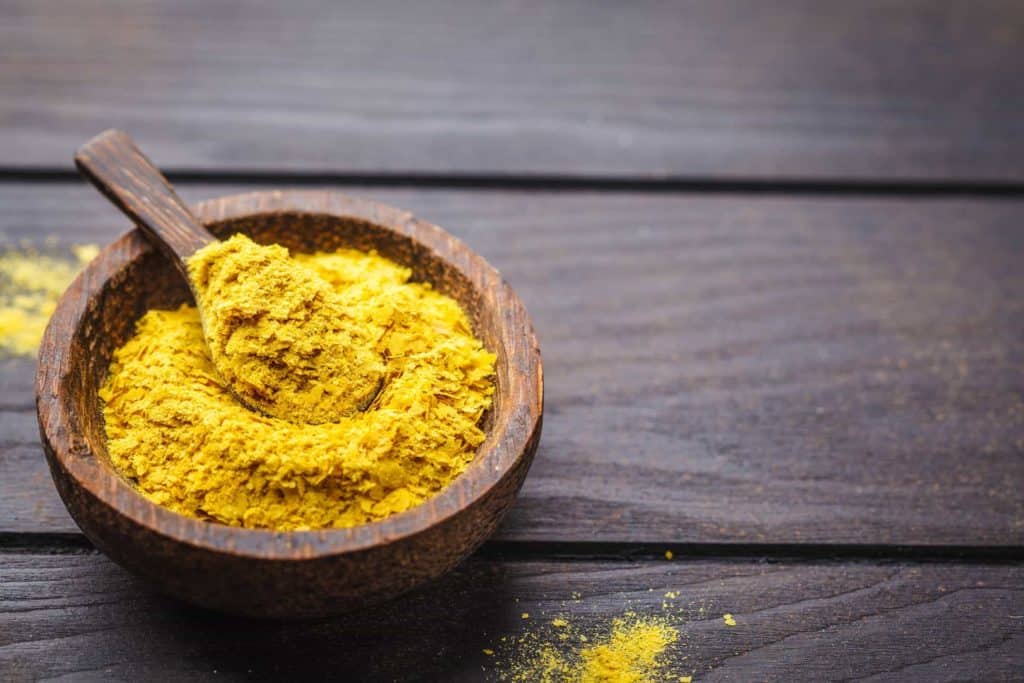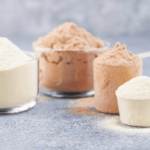
Tiana Hape-Cramond
(Associate Registered Nutritionist)
Note — The article was checked and updated November 2023.
Jump to:
- What is Vitamin B1?
- Vitamin B1 deficiency
- Different types of Vitamin B1
- Health Benefits
- Health Claims
- Best sources of Vitamin B1
- Daily requirements and intake
- How to take Vitamin B1
- Signs and symptoms of deficiency
- Risks and side effects
- Interactions - herbs and supplements
- Interactions - medication
- Summary
- Related Questions
Vitamin B1, also known as thiamine, is an essential nutrient needed for important processes in our body such as cell function, growth and development.
Normally, vitamin B1 deficiency is not very common in first world countries as there are sufficient amounts of vitamin B1 in the diet.
However, there are populations and vulnerable groups where thiamine deficiency is more prevalent. These include long-term dialysis patients, chronic alcoholics, old age and more.
Understanding the signs and symptoms of thiamine deficiency, the health benefits and risks of taking thiamine will provide more insight into our diet and we’ll see if additional supplementation is needed.
What is Vitamin B1?
Thiamine, also known as Vitamin B1, has an essential role for normal cell function, growth and development as well as being important for energy conversion in the body.
Thiamine was the first water-soluble vitamin to be investigated which led to the discovery of more trace compounds.

Thiamine deficiency was known as beriberi in English and kakke in Japan and China.
Beriberi symptoms include loss of sensation in hands and feet and muscle weakness. Beriberi was first believed to be caused by poisonous gasses rising from the wet soil, then later it was thought to be caused by infectious organisms.
Later in the 1880s systematic reviews were conducted in the Dutch East Indies in response to the beriberi among the troops. Beriberi was becoming more prevalent and problematic.
In Japan, Kanehiro Takaki, a surgeon general in the Japanese Imperial Navy, discovered a relationship between the sailors’ diets and the development of beriberi. The white rice diet was replaced with barley, vegetables, fish and meat and the sailors’ symptoms improved.
Many scientists and medical professionals investigated beriberi and the unknown cause. In 1936, Robert Williams synthesized thiamine using a pure solution of the vitamin and added sodium sulfate. Simpler synthesized vitamins were then commercially sold and the prevalence of beriberi dropped significantly.[1]
In 1991, Australia New Zealand Food Standards Code required the mandatory thiamine fortification of wheat flour for bread. This was put in place to minimize the incidence of Wernicke-Korsakoff syndrome.[2]
Vitamin B1 deficiency
The causes of vitamin B1 deficiency are lower absorption or higher excretion rates, some medications and lack of foods containing thiamine.
Vitamin B1 deficiency is known as beriberi
Beriberi is rare in most developed countries and the more common manifestation of thiamine deficiency for developed countries is Wernicke-Korsakoff syndrome. This syndrome is characterized by peripheral neuropathy and is 8 to 10 times more likely to occur in people with chronic alcoholism.
The body can store about 20 days of thiamine, and thiamine deficiency can begin to manifest after 3 weeks.
The World Health Organization recommends daily oral doses of 10mg of thiamine for a week, then 3-5mg/daily for 6 weeks to treat mild thiamine deficiency.
Who is most at risk of Vitamin B1 deficiency?
Chronic Alcoholism and thiamine deficiency
Chronic alcohol use appears to be the most common cause of thiamine deficiency. Over 80% of people with chronic alcoholism develop a thiamine deficiency as the ethanol reduces the gastrointestinal absorptions of thiamine.[3]
Old Age and thiamine levels
Older adults have a higher risk of thiamine deficiency, with 20-30% having some degree of deficiency. Possible explanations for this are
- Low dietary intakes
- Other chronic disease
- Uses of multiple medications
- Low absorption of thiamine as a result of aging.[3]
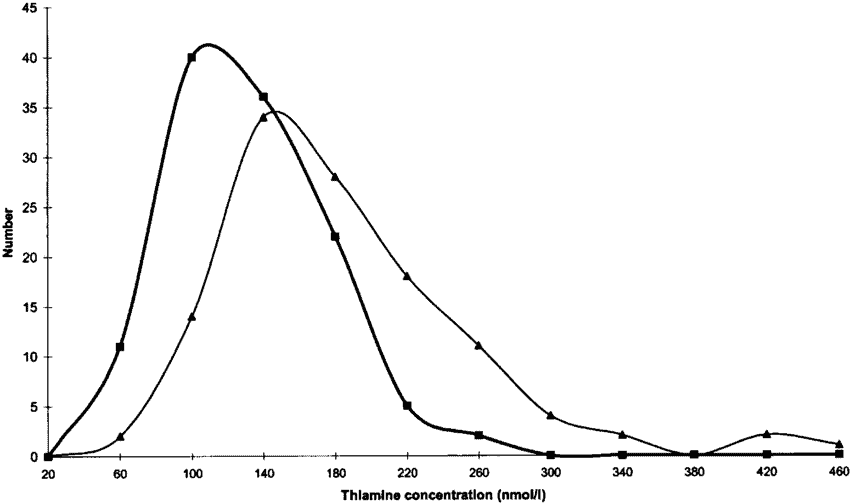
In the image above we can see how the levels of thiamine decrease with age (3-year study).
The impact of fad diets on thiamine
People on fad diets are at a higher risk of developing a thiamine deficiency. This is due to the elimination of certain foods in the diet. By cutting out many foods, we decrease the variety of foods that contain the essential nutrients the body needs.
RELATED — A Guide to Mindful Eating
The effects of dialysis on thiamine
People on long-term peritoneal dialysis without thiamine replacement are at risk of thiamine deficiency. Thiamine is lost through the dialysis and without a replacement, the lack of thiamine intake from food, patients are at risk of developing a deficiency.[4]
Impact of long-term starvation on thiamine levels
People undergoing long-term starvation, those who have undergone gastrointestinal surgery, and anorexia nervosa (eating disorder) are at a high risk for developing a thiamine deficiency because of the malabsorption or lack of thiamine through oral intake.[3]
RELATED — Understanding Eating Disorders: History, Types and Statistics
Thiamine and impact on tumor growth
Patients with some cancers are at a higher risk of developing vitamin B1 deficiency. Some cancers use thiamine to rapidly grow tumors and some chemotherapy drugs can interfere with the functions of thiamine.[4]
Refined carbohydrates and thiamine deficiency
People who enjoy a diet of highly refined carbohydrates such as polished rice and white flour are at higher risk of developing thiamine deficiency.

HIV risk of thiamine deficiency
Thiamine deficiency risk is higher in people with HIV infection. This is theorized to be due to the malnutrition caused by the catabolic state associated with AIDS.[3]
Different types of Vitamin B1
Vitamin B1 is an important nutrient that can be taken both orally and intravenously. The type of thiamine can also be important.
Vitamin B1 comes in four different forms
- Thiamine hydrochloride
- Thiamine mononitrate
- Thiamine monophosphate
- Benfotiamine
Thiamine hydrochloride
Thiamine hydrochloride is the salt form of thiamine that is essential for aerobic metabolism, cell growth, transmission of nerve impulses and acetylcholine synthesis. This form of vitamin B1 is one of the most common forms found in supplements because it is stable and water soluble.[5]
Thiamine mononitrate
Thiamine mononitrate is the generic name of some vitamin B1 in tablet form. This is a synthetic stable nitrate salt form of vitamin B1.[6]
This form of thiamine can be added to certain foods to maintain nutrient content during processing.[7] As a supplement, thiamine mononitrate can be used to treat and prevent thiamine disorders and deficiencies.
Thiamine monophosphate
This form of thiamine has a role as a metabolite, which is a substance produced during metabolism.[8] Thiamine monophosphate is an intermediary for thiamine pyrophosphate which is the active form of thiamine and is essential as a coenzyme in carbohydrate metabolism.[9]
Benfotiamine
Benfotiamine is a synthetic form of thiamine supplement. This nutritional supplement is used to treat diabetic neuropathy and Alzheimer’s disease.
Benfotiamine is the best form of vitamin B1
This form is absorbed faster by the body and is used frequently to increase thiamine levels.
Health benefits of vitamin B1
Thiamine has many important functions within the body. Supplying the body with optimal amounts of thiamine may have health benefits such as
- boosting energy production
- reducing the effects of sepsis
- decreasing depression symptoms
and more listed below.
Boosting energy production
Thiamine is important for energy production. When there is a deficiency of thiamine in the body, the most common symptom is fatigue.
A study performed using 16 male athletes found that a high-dose of thiamine 3 days before exercise can significantly decrease fatigue complaints after exercise.
Using fatigue symptoms (less being better), those treated with thiamine scored 2, whereas those treated with the placebo scored 4 on a scale of 1 to 5.[10]
Reducing the effects of sepsis
During sepsis, thiamine levels are depleted in patients. Using thiamine as a monotherapy, an observational study recorded that adults with septic shock had a significant reduction in mortality when receiving thiamine.
Around 44% of patients receiving thiamine died which is significantly lower than the 79% of patient deaths of those who did not receive a thiamine dose.[11]
Helping with depression
Among a sample of inpatients with major depressive disorder, it was found that thiamine can improve depression symptoms.

After 6 weeks of taking thiamine, 92% of patients were either in full remission or partial remission.
This is significantly different from those on a placebo, which found 44% in partial remission, and with no full remissions recorded.[12]
RELATED — Introduction to: Depression
Thiamine and diabetes
Thiamine deficiency was found in 76% of patients with type 1 diabetes and 75% of patients with type 2 diabetes. High dose therapy of thiamine can be used to treat thiamine deficiency that occurs with diabetes.
RELATED — Diabetes: Early Signs, Causes, Types and Treatment
When thiamine is given to those with diabetes, the development of diabetic nephropathy, neuropathy and retinopathy were prevented. Thiamine was also shown to correct dyslipidemia in experimental diabetes and normalizing cholesterol and triglycerides.[13]
Thiamine deficiency is found in 75% of people with diabetes
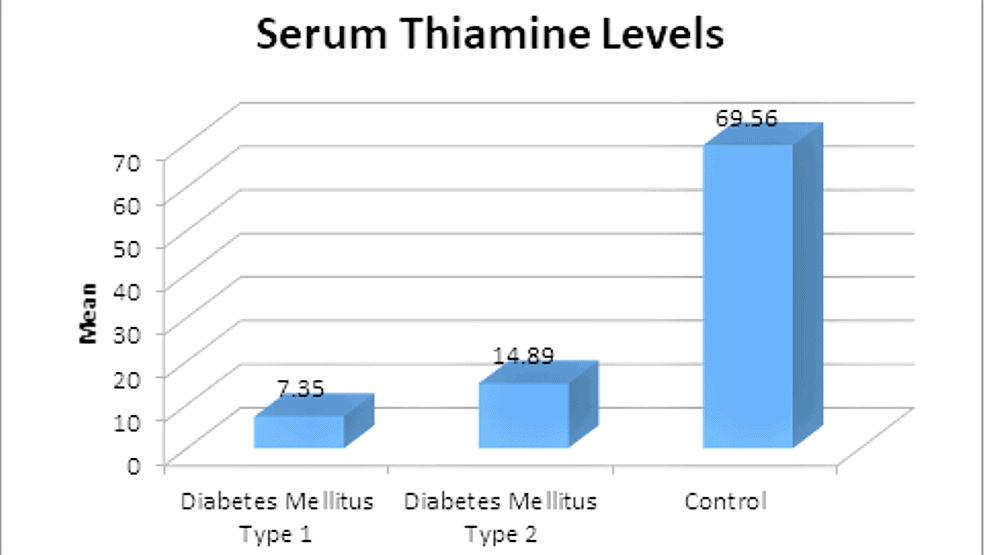
Preventing kidney issues
Normally, protein is kept in the blood. If kidneys are not functioning properly or damaged, this can lead to poor reabsorption of the proteins or excess protein which will flow into the urine.
Research from a pilot study using thiamine therapy on individuals with diabetes-related kidney disease found that after 3 months of treatment the levels of protein in the urine decreased and 35% of participants had normal levels. This presence of albumin, which is protein within the urine is a sign of kidney damage.[14]

Effect of high-dose thiamine on UAE. Change from baseline of UAE in type 2 diabetic patients receiving thiamine (black squares) or placebo (white squares). Decrease in urinary albumin in those receiving thiamine overtime.
Improving cardiovascular health
Thiamine may be related to heart failure due to the diuretics taken.
A study demonstrated patients with heart failure who were given 200mg/day of thiamine for a week found that left ventricular ejection fraction improved in 80% of the patients.[15]
Improving memory and brain function
Thiamine deficiency can cause Wernicke-Korsakoff syndrome which has similar mental changes to Alzheimer’s disease including
- Memory defects
- Disorientation
- Confabulation
Those treated with a high quality diet and thiamine supplements showed a recovery 7 times greater than those only treated with diet.[16]
Health claims that still need more evidence and research
Myocardial infarction and thiamine
Myocardial infarction is a serious condition that is caused by a lack of blood flow to the heart muscle.
Thiamine is known to improve blood pressure and links to benefits in cardiovascular health, but further human research is needed to assess the role of thiamine myocardial infarction and conduction defects.
Alzheimer’s disease and thiamine deficiency
Elderly patients with Alzheimer’s disease have been noted to have low thiamine levels. As Wernicke-Korsakoff syndrome has similar symptoms, it is thought that thiamine may be used to alleviate symptoms. But more research is needed to determine the use of thiamine as treatment for Alzheimers disease.[17]
Using thiamine as treatment for motion sickness
Motion sickness treatment with a combination of vitamins A, C, thiamine, nicotinic acid, riboflavin, and pyridoxine has been shown to be effective.
RELATED — Vitamin B2 (Riboflavin)
However, more conclusive research and isolation of the effect of thiamine has to be confirmed.[18]
Cancer and thiamine connection
Thiamine deficiency has been noted in cancer patients.[19] Currently, research is ongoing to better understand the possible connection between thiamine and cancer.
Thiamine uses in pregnancy
During pregnancy the requirement for thiamine increases over the gestation period.
Toxemia, also known as preeclampsia, is a complication in pregnancy which results in high blood pressure and damage to other organs such as kidneys or liver. More
research is needed into the relationship between thiamine and preeclampsia.
Best sources of Vitamin B1
Eating foods high in thiamine are important for maintaining optimal thiamine levels in the body.
Some foods containing thiamine are fortified foods, lentils and meats, and some vegetables.
| Food sources | Concentration (mg/100g) | Daily Value (DV) Men/Women |
| Yeast | 2.33mg | 190% / 211% |
| Fortified Breakfast Cereals | 1.92mg | 160% / 174% |
| Oats | 0.76mg | 63% / 69% |
| Lentils | 0.50mg | 41% / 45% |
| Pork | 0.49 – 0.92mg | 40% – 76% / 44% – 83% |
| Green Peas | 0.27mg | 22% / 24% |
| Kale | 0.20mg | 16% / 18% |
| Rice | 0.12mg | 10% / 11% |
| Sunflower seeds | 0.11mg | 9% / 10% |
| Orange | 0.12mg | 10% / 11% |
| Chicken liver | 0.36mg | 30% / 32% |
| Potato | 0.10mg | 8% / 9% |
| Egg | 0.07mg | 5% / 6% |
| Asparagus | 0.07mg | 5% / 6% |
| Tuna | 0.05mg | 4% / 4% |
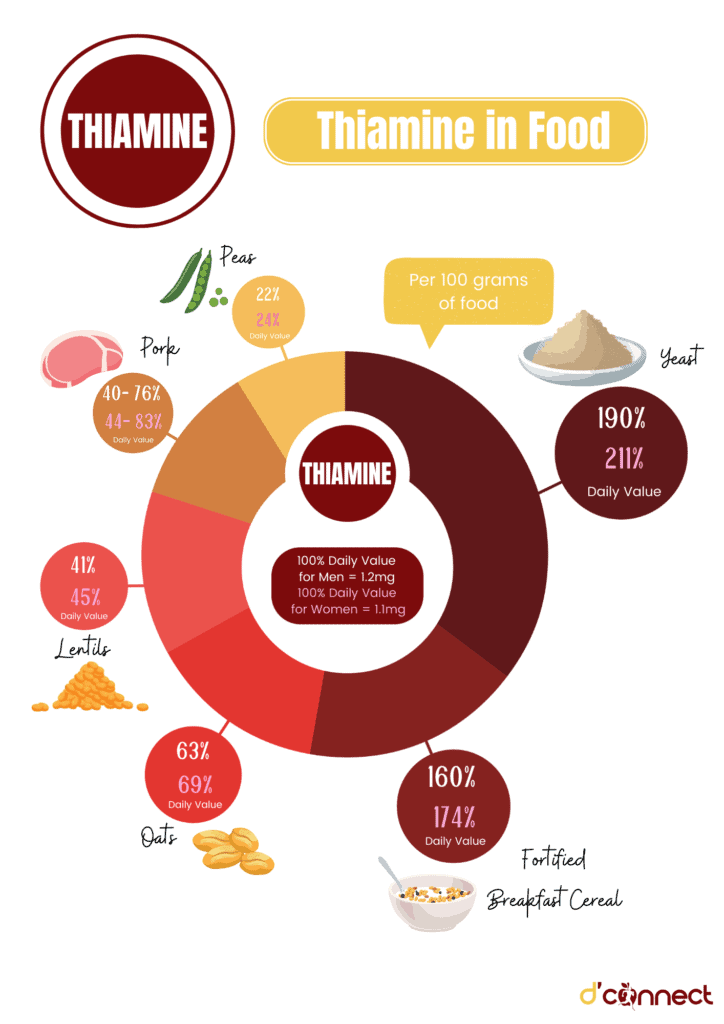
Note — if your usual breakfast are cereal or oats, you should have adequate thiamine levels.
Daily requirements and recommended intake
Daily requirements for thiamine can be divided per age and gender.
Age | Male | Female |
1-3 years | 0.5mg | 0.5mg |
4-8 years | 0.6mg | 0.6mg |
9-13 years | 0.9mg | 0.9mg |
14-18 years | 1.2mg | 1.1mg |
19-30 years | 1.2mg | 1.1mg |
31-50 years | 1.2mg | 1.1mg |
>70 years | 1.2mg | 1.1mg |
During pregnancy or lactation, it is suggested that thiamine daily intake is increased to 1.4mg per day.
How to take Vitamin B1
When taking vitamin B1 as a supplement, take as directed on the bottle – one a day taken with food.[20]
Taking a multivitamin that contains thiamine is a sufficient dose of daily thiamine.
Those with a thiamine deficiency receive 10-50mg/day orally and beriberi treatment requires 5-30mg of thiamine injected three times a day.[21]
Common signs and symptoms of Vitamin B1 deficiency
Signs and symptoms of thiamine deficiency generally develop over weeks to months. Recognising the early symptoms can help for an early diagnosis for treatment.
Loss of appetite
Loss of appetite can be a sign of vitamin B1 deficiency. This may be linked to the potential influence thiamine has on the hunger and fullness cues of the brain. Therefore, inadequate intake of thiamine could disrupt the process of making the body think it’s full when it is not.[22]

Mice (male and female) were fed with either a control or TD (thiamine deficiency) diet. A significant decrease in the food intake was observed on the 16th day in the TD group. Also, a significant decrease in the body weight was observed from the 21st day for male and the 23rd day for female mice in the TD group.
Fatigue
Fatigue is recognised as a symptom of vitamin B1 deficiency. As thiamine has a role in converting food into energy, having a deficiency in this vitamin means that there is less energy being converted. This also ties in to the loss of appetite because there is less food being consumed.
Irritability
Feeling irritable and easily upset is an early sign of thiamine deficiency and may present within a few weeks. This irritability may be due to the change in brain energy and compromised synthesis of neurotransmitters.[23]
Low levels of thiamine can cause mood changes
Slower reflexes
Slow reflexes are a symptom of vitamin B1 deficiency. Damage to the nerves, due to a thiamine deficiency, can cause reflexes in the body to be delayed.[24]
Muscle weakness
Lactic acidosis may be the cause of muscle weakness, due to a lack of thiamine supply in the body. Thiamine has an important function in mitochondria, and low levels can cause a dysfunction resulting in muscle weakness.[25]
Tingling sensation in the limbs
Although the tingling sensation in the arms and legs can be a sign of beriberi, it is also an early symptom of thiamine deficiency. Thiamine is important for nerve function and low levels of thiamine can result in having a tingling sensation.[26]
Blurry vision
Thiamine has an important role in maintaining functional nerves and the deficiency can affect the optic nerve which controls vision.
Thiamine deficiency may cause swelling of the optic nerve which could lead to blurred vision. Treating this early will prevent nerve damage and loss of vision.[24]

Nausea and vomiting
Similarly to fatigue and irritability, nausea and vomiting is a common symptom of many conditions which include thiamine deficiency. This symptom is more common in Wernicke encephalopathy which is a thiamine deficiency related condition.[24]
Beriberi
Dry beriberi is a peripheral neurological symptom of thiamine deficiency. Signs of dry beriberi are
- Paresthesias in the toes
- Burning in the feet
- Muscle cramps in the calves
- Pains in the legs
Continued deficiency worsens polyneuropathy and can eventually extend pains to the arms.
Wet beriberi is a myocardial disease that affects vasodilation, tachycardia, pulse pressure, sweating, warm skin and lactic acidosis. This can escalate to heart failure and cause pulmonary and peripheral edema.
Wernicke-Korsakoff Syndrome
Wernicke-Korsakoff is a degenerative brain disorder caused by lack of thiamine in the body. Other causes of this disorder are long-term high alcohol consumption, dietary deficiencies, prolonged vomiting or eating disorders.
Wernicke-Korsakoff occurs in some alcoholics who don’t consume foods rich in thiamine. This causes psychomotor slowing and impaired consciousness and left untreated may lead to a coma or death.[27]
Vitamin B1 risks and side effects
It is unlikely to reach a toxic level of thiamine from food sources. At times of high thiamine intakes, the body will absorb less thiamine and flush out the excess.
There is no upper limit for thiamine and doses up to 50mg appear to be safe.[28]
Serious side effects of thiamine are
- Blue coloured lips
- Chest pain or shortness of breath
- Black, bloody or tarry stool
- Coughing up blood or vomit
If you are experiencing these side effects, call a doctor.
Less serious side effects include
- Nausea or tight feeling in your throat
- Sweating
- Feeling warm
- Feeling restless
- Rapid heartbeat
- Swelling of the face or other allergic reactions[29]
Thiamine hydrochloride, a synthetic form of vitamin B1, can cause allergic reactions and other side effects including stomach pains, arrhythmia, eye irritation, vomiting and diarrhea.
Another common side effect of excessive thiamine intake is stomach upset. Additionally, ingesting large amounts of thiamine or other B vitamins for a long period of time can affect the overall vitamin B levels in the bloodstream.[28]
Possible interactions with herbs and supplements
Betel nuts can change the chemical structure of thiamine which inhibits thiamine from working effectively. Regular or long-term chewing of these nuts may contribute to vitamin B1 deficiency.
Another herb that has an interaction with thiamine is horsetail. Horsetail or equisetum contains a chemical that can destroy thiamine in the stomach which can lead to a thiamine deficiency.
Tannins, which are found in coffee and tea, react with thiamine that converts thiamine into a form that is difficult for the body to absorb.[30]
Possible interactions with medications
Thiamine has no severe interactions with pharmaceutical drugs. However, there are some drugs that should be monitored closely when taking thiamine.
Antibiotics such as
- Azithromycin
- Clarithromycin
- Erythromycin base
- Erythromycin ethylsuccinate
- Erythromycin lactobionate
- Erythromycin stearate
can decrease the level or effect of thiamine by altering intestinal flora.
The drug omadacycline inhibits gastrointestinal absorption which will decrease the level of thiamine.[31]
Digoxin, a medication used to treat heart conditions, may reduce the ability of the heart’s cells to absorb and use vitamin B1.
Diuretics, particularly furosemide, may reduce levels of vitamin B1 in the body. It is possible that other diuretics have the same effect.
There has been some evidence that those who are taking phenytoin have lower levels of thiamine in their blood which could be a side effect of the drug.[32]
It is important to consult with your doctor when taking these drugs and the potential need for thiamine supplements.
Summary
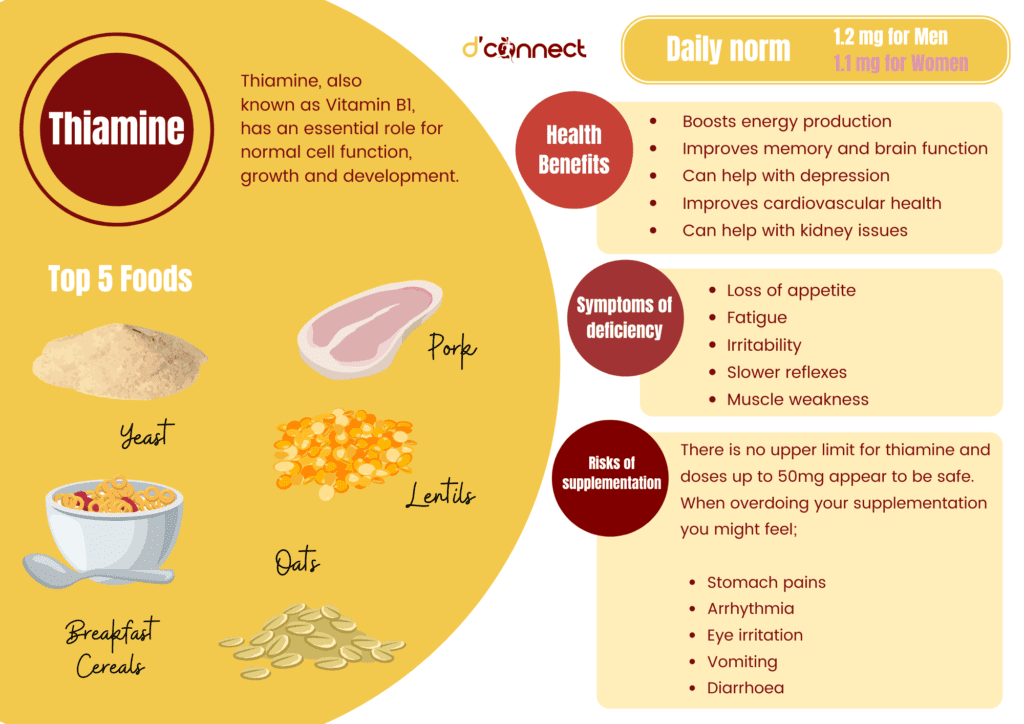
Key Takeaway – In this summary illustration we have outlined the most important information that you should know about Thiamine (vitamin B1).
Related Questions
1. What does vitamin B1 do for alcoholics?
High doses of vitamin B1 may repair brain systems damaged by alcohol. Benfotiamine was used in men and may facilitate alcohol rehabilitation.[33]
2. Does thiamine increase metabolism?
Vitamin B1 is important for the metabolism and brain function. Thiamine helps the body metabolize carbohydrates.[34]
3. Will thiamine make me gain weight?
Vitamin B1 is important for a functioning metabolism and converts carbohydrates into energy. Low levels of thiamine means that metabolism won’t be functioning properly and it makes losing weight harder.
4. Does thiamine break down glucose?
Thiamine is used to break down glucose. Excessive intake of this simple carbohydrate means an increased need for vitamin B1.[35]
5. Can thiamine help with erectile dysfunction?
Vitamin B1 is responsible for nerve conduction and it may help improve nerve function and help with erectile dysfunction.[36]
Let us know in the comments below if we covered everything in this article and if there is something else to add. Also, do you think that you are getting adequate amounts of thiamine through your diet?
Tiana is an Associate Registered Nutritionist who has a passion for public health and education. Working towards a Master’s in Nutrition Practice with a Bachelor’s in Human Nutrition, Tiana has a personal interest in healthy heart nutrition and promoting positive lifestyle behaviours.
Tiana is a part of the Content Team that brings you the latest research at D’Connect.
References
(1) Carpenter KJ. The discovery of thiamin. Ann Nutr Metab. 2012;61(3):219-23. doi: 10.1159/000343109. Epub 2012 Nov 26. PMID: 23183292.
(2) Thiamine fortification [Internet]. Food Standards 2016 [cited 2022 Feb 8].
(3) Office of Dietary Supplements – Thiamin [Internet]. Nih.gov. 2013 [cited 2022 Feb 9]. Available from: https://ods.od.nih.gov/factsheets/Thiamin-HealthProfessional/#h7
(4) Thiamine Deficiency — RDs Are Key Players in Prevention and Treatment [Internet]. Todaysdietitian.com. 2022 [cited 2022 Feb 9]. Available from: https://www.todaysdietitian.com/newarchives/100610p78.shtml
(5) PubChem. Thiamine hydrochloride [Internet]. PubChem; 2022 [cited 2022 Feb 2]. Available from: https://pubchem.ncbi.nlm.nih.gov/compound/Thiamine-hydrochloride#:~:text=Thiamine%20Hydrochloride%20is%20the%20hydrochloride,nerve%20impulses%20and%20acetylcholine%20synthesis.&text=Thiamine%20hydrochloride%20is%20a%20hydrochloride,molar%20equivalent%20of%20hydrochloric%20acid.
(6) Thiamine mononitrate. Sigmaaldrich.com [Internet]. 2022 [cited 2022 Feb 2]; Available from: https://www.sigmaaldrich.com/NZ/en/product/sigma/smb00294
(7) Flood, A. Food Additives and Ingredients: Hard to Pronounce, Safe to Use [Internet]. Food Insight. 2016 [cited 2022 Feb 2]. Available from: https://foodinsight.org/food-additives-and-ingredients-hard-to-pronounce-safe-to-use/#:~:text=Thiamine%20mononitrate%20is%20also%20known,is%20there%20for%20good%20reason.
(8) PubChem. Thiamine monophosphate [Internet]. PubChem; 2022 [cited 2022 Feb 2]. Available from: https://pubchem.ncbi.nlm.nih.gov/compound/Thiamine-monophosphate
(9) Zeece M. Vitamins and minerals. Introduction to the Chemistry of Food [Internet]. 2020 [cited 2022 Feb 2];163–212. Available from: https://www.sciencedirect.com/topics/agricultural-and-biological-sciences/thiamine-pyrophosphate
(10) Suzuki M, Itokawa Y. Effects of thiamine supplementation on exercise-induced fatigue. Metabolic brain disease. 1996 Mar;11(1):95-106.
(11) Holmberg, M. J. et al. Thiamine in septic shock patients with alcohol use disorders: an observational pilot study. J. Crit. Care 43, 61–64 (2018).
(12) Ghaleiha A, Davari H, Jahangard L, Haghighi M, Ahmadpanah M, Seifrabie MA, Bajoghli H, Holsboer-Trachsler E, Brand S. Adjuvant thiamine improved standard treatment in patients with major depressive disorder: results from a randomized, double-blind, and placebo-controlled clinical trial. European archives of psychiatry and clinical neuroscience. 2016 Dec: 266(8):695-702.
(13) Thornalley PJ. The potential role of thiamine (vitamin B1) in diabetic complications. Current diabetes reviews. 2005 Nov 1;1(3):287-98.
(14) Rabbani N, Alam SS, Riaz S, Larkin JR, Akhtar MW, Shafi T, Thornalley PJ. High-dose thiamine therapy for patients with type 2 diabetes and microalbuminuria: a randomized, double-blind placebo-controlled pilot study. Diabetologia. 2009 Feb;52(2):208-12. Available from: https://link.springer.com/article/10.1007/s00125-008-1224-4
(15) Seligmann H, Halkin H, Rauchfleisch S, Kaufmann N, Tal R, Motro M, Vered ZV, Ezra D. Thiamine deficiency in patients with congestive heart failure receiving long-term furosemide therapy: a pilot study. The American journal of medicine. 1991 Aug 1;91(2):151-5. Available from: https://www.sciencedirect.com/science/article/pii/000293439190007K?casa_token=RSBoXmjGwMQAAAAA:IwP3Kf4QNJLtYYlLBwn4QJyxZQtNuDq4-iJsrGH_L8e8lGSMbYn91jusXaQHlreNo1LhhlPubg
(16) Gibson GE, Hirsch JA, Fonzetti P, Jordon BD, Cirio RT, Elder J. Vitamin B1 (thiamine) and dementia. Annals of the New York Academy of Sciences. 2016 Mar;1367(1):21. Available from: https://www.ncbi.nlm.nih.gov/pmc/articles/PMC4846521/
(17) Lu’o’ng KV, Nguyễn LT. Role of thiamine in Alzheimer’s disease. American Journal of Alzheimer’s Disease & Other Dementias®. 2011 Dec;26(8):588-98. Available from: https://journals.sagepub.com/doi/full/10.1177/1533317511432736
(18) Wood CD. Medications for Vertigo and Motion Sickness. The American Journal of Nursing. 1966 Aug 1:1764-7.
(19) Boros LG, Brandes JL, Lee WN, Cascante M, Puigjaner J, Revesz E, Bray TM, Schirmer WJ, Melvin WS. Thiamine supplementation to cancer patients: a double edged sword. Anticancer research. 1998 Jan 1;18(1B):595-602.
(20) NHS Choices. Thiamine (vitamin B1) [Internet]. 2022 [cited 2022 Feb 7]. Available from: https://www.nhs.uk/medicines/thiamine-vitamin-b1/
(21) Thiamine [Internet]. RxList. RxList; 2021 [cited 2022 Feb 3]. Available from: https://www.rxlist.com/consumer_thiamine_vitamin_b1/drugs-condition.htm
(22) Liu M, Alimov AP, Wang H, Frank JA, Katz W, Xu M, Ke ZJ, Luo J. Thiamine deficiency induces anorexia by inhibiting hypothalamic AMPK. Neuroscience. 2014 May 16;267:102-13. doi: 10.1016/j.neuroscience.2014.02.033. Epub 2014 Mar 5. PMID: 24607345; PMCID: PMC3995829. Available from: https://www.ncbi.nlm.nih.gov/pmc/articles/PMC3995829/
(23) Hammond N, Wang Y, Dimachkie MM, Barohn RJ. Nutritional neuropathies. Neurologic clinics. 2013 May 1;31(2):477-89. Available from: https://www.ncbi.nlm.nih.gov/pmc/articles/PMC4199287/
(24) Panoff L. What Is Thiamine Deficiency? All You Need to Know [Internet]. Healthline. Healthline Media; 2021 [cited 2022 Feb 8]. Available from: https://www.healthline.com/nutrition/thiamine-deficiency-symptoms#treatment
(25) Dhir S, Tarasenko M, Napoli E, Giulivi C. Neurological, psychiatric, and biochemical aspects of thiamine deficiency in children and adults. Frontiers in psychiatry. 2019:207.
(26) Huertas-González N, Hernando-Requejo V, Luciano-García Z, Cervera-Rodilla JL. Wernicke’s Encephalopathy, Wet Beriberi, and Polyneuropathy in a Patient with Folate and Thiamine Deficiency Related to Gastric Phytobezoar. Case Rep Neurol Med. 2015;2015:624807. doi: 10.1155/2015/624807. Epub 2015 Nov 30. PMID: 26697247; PMCID: PMC4677180.
(27) Johnson LE. Thiamin Deficiency [Internet]. MSD Manual Professional Edition. MSD Manuals; 2020 [cited 2022 Feb 10]. Available from: https://www.msdmanuals.com/en-nz/professional/nutritional-disorders/vitamin-deficiency,-dependency,-and-toxicity/thiamin-deficiency
(28) Picincu A. Vitamin B1 Overdose Symptoms [Internet]. Livestrong.com; 2011 [cited 2022 Feb 11]. Available from: https://www.livestrong.com/article/367247-vitamin-b1-overdose-symptoms/
(29) Thiamine (Vitamin B1) – Side Effects, Interactions, Uses, Dosage, Warnings [Internet]. EverydayHealth.com. 2020 [cited 2022 Feb 11]. Available from: https://www.everydayhealth.com/drugs/thiamine-vitamin-b1
(30) Thiamine: MedlinePlus Supplements [Internet]. Medlineplus.gov. 2021 [cited 2022 Feb 3]. Available from: https://medlineplus.gov/druginfo/natural/965.html#DrugInteractions
(31) Vitamin B1 (thiamine) dosing, indications, interactions, adverse effects, and more [Internet]. Medscape.com. 2019 [cited 2022 Feb 3]. Available from: https://reference.medscape.com/drug/vitamin-b1-thiamine-344428#0
(32) Vitamin B1 (Thiamine) | Complementary and Alternative Medicine | St. Luke’s Hospital [Internet]. Stlukes-stl.com. 2022 [cited 2022 Feb 14]. Available from: https://www.stlukes-stl.com/health-content/medicine/33/000333.htm
(33) Manzardo AM, Pendleton T, Poje A, Penick EC, Butler MG. Change in psychiatric symptomatology after benfotiamine treatment in males is related to lifetime alcoholism severity. Drug and alcohol dependence. 2015 Jul 1;152:257-63.
(34) Calla Slimspa Medical Weight Loss Center [Internet]. Calla Slimspa Medical Weight Loss Center. 2015 [cited 2022 Feb 8]. Available from: https://www.callaslimspa.com/blog/how-b-vitamins-impact-your-metabolism-and-help-weight-loss/
(35) Lonsdale D. A review of the biochemistry, metabolism and clinical benefits of thiamin (e) and its derivatives. Evidence-Based Complementary and Alternative Medicine. 2006 Mar 1;3(1):49-59. https://www.hindawi.com/journals/ecam/2006/349513/
(36) National Nutrition. Erectile Dysfunction [Internet]. National Nutrition. National Nutrition; 2015 [cited 2022 Feb 8]. Available from: https://www.nationalnutrition.ca/articles/health-concerns/erectile-dysfunction/

